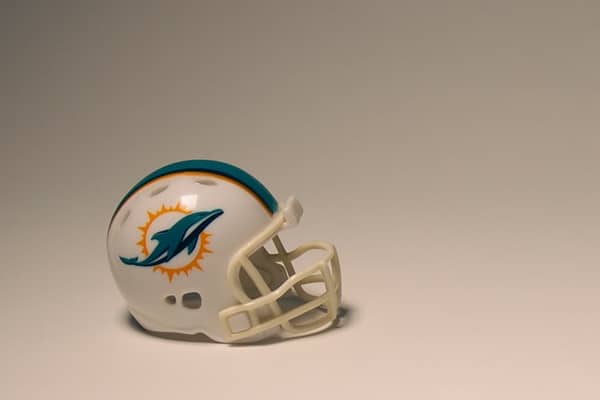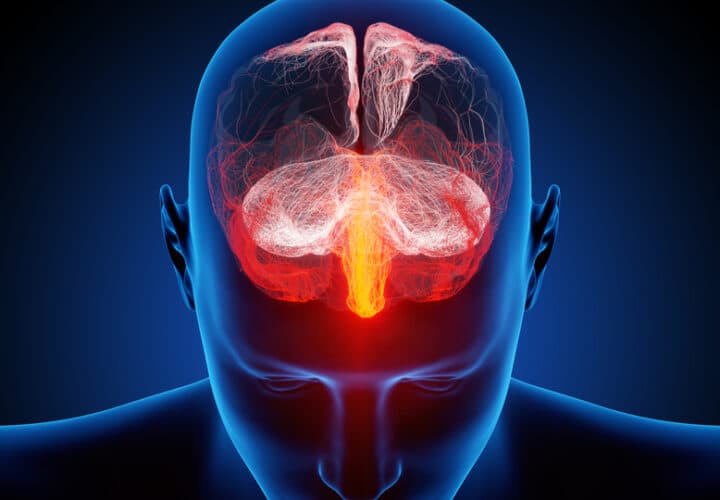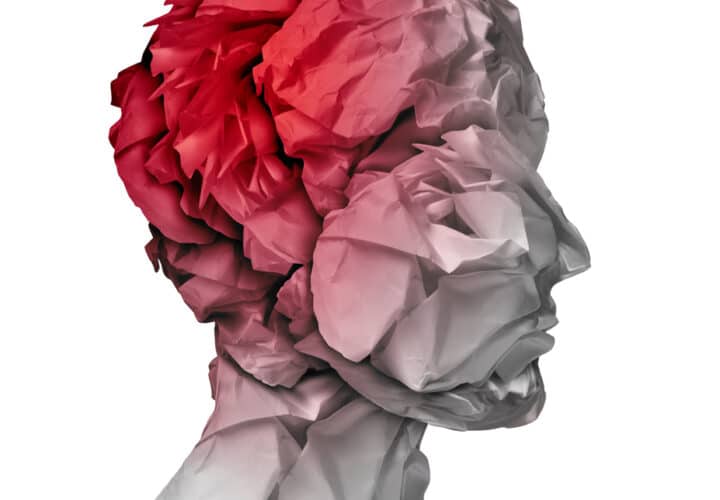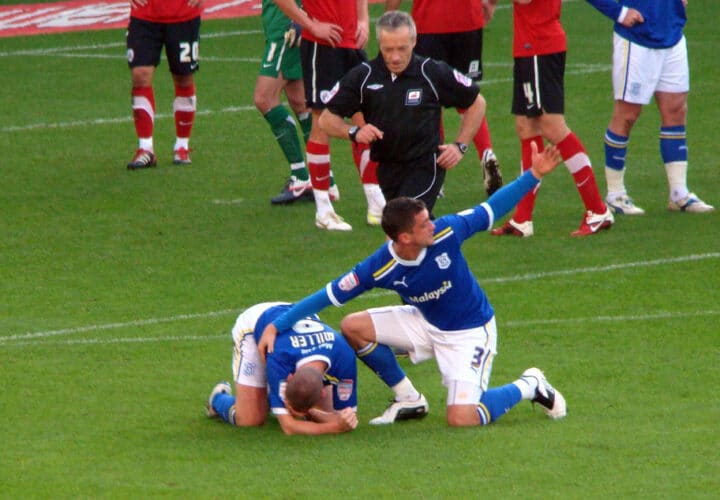Miami Dolphins quarterback Tua Tagovailoa was allowed to take the field just days after hitting his head in gameplay. He suffered another potentially devastating head injury four days later. Neurological experts say it's a concussion. Here's why that could matter long after the season is over.
Last week, star quarterback for the Miami Dolphins Tuanigamanuolepola “Tua” Tagovailoa had an alarming head injury on the field – just days after a separate injury that experts say should have taken him out of gameplay. A flurry of questions are coming from fans and the sports media: Is the Dolphins quarterback OK? Will Tua be able to play again?
Research and general knowledge of the dangers of professional football is mounting: a widely publicized 2017 study out of Boston University found that a progressive and fatal brain disease called chronic traumatic encephalopathy, or CTE, in 99 percent of brains from deceased National Football League players. The NFL also paid 4,500 players $765 million to settle a lawsuit regarding brain injuries during players careers — and was tangled in another suit when 20,000 Black NFL players said they experienced racism in the NFL’s handling of dementia-related settlements.
And yet, a young star quarterback has just suffered two head injuries in a single week. Neurological experts say this could have resounding health consequences for Tagovailoa long after the season ends.
Head injuries in football: not just a game
The Boston University study found that for every 5.3 years that people play football, they double their risk of developing severe CTE. In another study between McMaster University and The Spectator, researchers conducted brain scans of two dozen retired Canadian Football League players to study the long-term consequences of repetitive head injuries – one of the largest studies conducted on living players.
“Brain images from some retired players in their 40s looked like the images of men in their 80s,” the researchers wrote.
What happened to Tua?
On Sunday, September 25th, during a game against the Buffalo Bills, Tagovailoa initially fell to the ground and hit his head after a run-in with opposing linebacker Matt Milano. Replay videos show Tagovailoa shaking his head and stumbling while trying to return to the huddle. He left the game for a brief break during the first half, but returned to the field after halftime. Trouble walking after a hit would usually constitute a “no-go” on returning to the game, per NFL concussion protocols. Still, head coach Mike McDaniel told reporters that the hit from Milano aggravated a lower back injury, which caused his head shaking and stumbling, rather than a potential neurological issue.
Then, just a few days later, during the September 29th game against the Cincinnati Bengals, defensive tackle Josh Tupou slammed into Tagovailoa. Again, Tagovailoa fell and head hit the ground, his arms and hands locked in a distressing, stiff posture called a “fencing response.”
Immediately, there was widespread outcry from across the spectrum: coaches, athlete advocates, and from brain trauma experts.
“Forget this back and ankle b.s. we heard about,” Rex Ryan, former Buffalo Bills and New York Jets coach, said on ESPN’s “Sunday NFL Countdown. “This is clearly from head trauma. That’s it. A concussion. I know what it looks like. We all know what it looks like.”
Baltimore Ravens coach John Harbaugh agreed: “I couldn’t believe what I saw last Sunday,” Harbaugh said at a press conference. “Coaching for 40 years now, in college and the NFL, and I’ve never seen anything like it before.”
“This is clearly from head trauma. That’s it.
A concussion. I know what it looks like.
We all know what it looks like.”
–Rex Ryan, former Buffalo Bills and New York Jets coach
Sports medicine doctor Brian Sutterer explained the aforementioned locked posture on Twitter: “His fingers are rigid like that because of this continuous electrical signals being sent to those muscles as a result of that head trauma.”
Chris Nowinski, co-founder and CEO of the Concussion Legacy Foundation, explained further in an interview with People: “That [posture] means that his mid-brain was damaged, and it’s worse than your run-of-the-mill concussion. It’s something you usually only see in stroke patients after parts of their cortex have died. It’s a very uncomfortable thing to see.”
Tagovailoa lay on the ground, motionless, for approximately 12 minutes according to reports, and was eventually taken off the field on a stretche to University of Cincinnati Medical Center, and released in time to return on the plane to Miami with his teammates.
Why was Tua allowed to take the field after a head injury in Sunday’s game?
According to the NFL’s concussion protocol, if a player shows “gross motor instability,” such as stumbling and trouble walking, he is supposed to be out for the rest of the game. This is to make sure the player gets any immediate treatment that may be needed, but it’s also because, in the time following a head injury, the brain is especially fragile, according to Alex Gometz, the founder of Concussion Management New York.
“If you’re getting exposed to a second injury before the symptoms resolve, you’re risking that possibility of second impact syndrome,” Gometz told Being Patient.
But the Sunday injury ended up falling into a loophole in the rules: instability is a ‘no-go’ symptom, meaning the player can’t return to the field, unless it is attributable to an orthopedic cause, rather than a neurological one.
“If you’re getting exposed to a second injury
before the symptoms resolve, you’re risking
that possibility of second impact syndrome.”
–Alex Gometz, Concussion Management New York
Since coach Mike McDaniel was able to write off the stumble as related to a back injury, Tagovaliloa was able to continue playing without going through full concussion protocol. And, since Tagovaliloa returned to the field in the original game, he did not have to complete the five-step “return to participation” protocols outlined in the concussion protocols. The Dolphins stated on Monday that Tagovailoa was not participating in concussion protocols in the days between the games in question.
According to Kristine Keane, a clinical and sports neuropsychologist, and Clinical Director of the HMH Neuroscience Concussion Program, after a concussion, symptoms can develop over time. “In the first five minutes you may look fine,” she said. This is why it’s critical that time is taken to assess players after a head injury.
“When we work with youth athletes, we say, when in doubt, put them out, give them some time,” Keane told Being Patient. “I think that’s what people are looking to the NFL to do. To give it more time.”
Keane continued: “We’re doing that with the youth athletes, but we’re not seeing that with the professional athletes. That’s the call here: Let’s change the protocol and give this some more time off the field to make sure that the athlete is not concussed.”
After this past week’s events, experts are quick to point out that this hasn’t been sufficient. Accordingly, the league and the NFL Players Association, who collaborate on these protocols, agreed to update the protocols on October 1st, closing this loophole and making it so that a doctor or coach can’t interpret an injury as non-neurological in the interest of getting the player prematurely removed from concussion protocol and back on the field.
Is the NFL doing enough to protect players like Tua from CTE?
Protecting players’ brains has been a long battle between advocates and the NFL. Decades of criticism have yielded incremental improvements: the introduction of safer helmets, rough pass penalties, installing a head-injury spotter in the press box, keeping independent doctors on the sidelines.
Football has come under fire in recent years as the prevalence of CTE has been increasingly discovered in players’ brains. CTE’s symptoms include memory loss and depression — and it also increases a person’s risk of developing dementia, Alzheimer’s, and other brain conditions. It can only be diagnosed after death, with a brain autopsy, but CTE has been found in the brain tissue of hundreds of former NFL players who died prematurely.
Neuropathologist Bennet Omalu, who is credited with discovering CTE, isn’t sure updated protocols will be enough to protect players’ lives. In a recent interview with TMZ, he broadcast a personal message to Tagovalioa: “Tua, my brother, I love you. I love you as much as I love my son. Stop playing. Stop. Hang your helmet and gallantly walk away,” Omalu said. “Sometimes money is not more valuable than human life. $20 billion is not worth more than your brain.”




